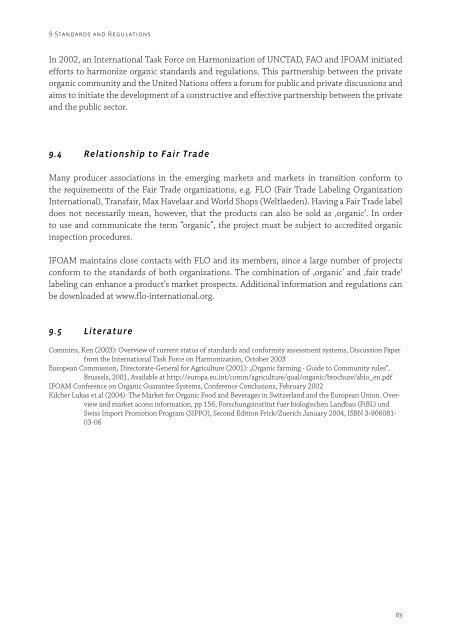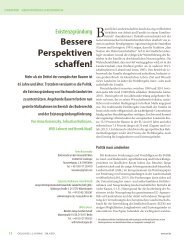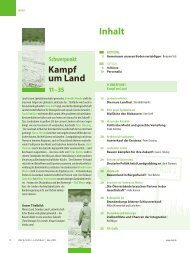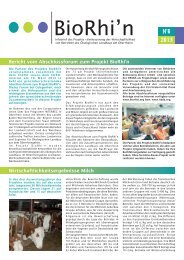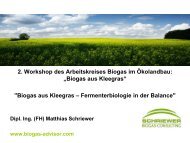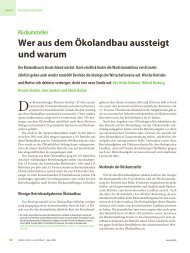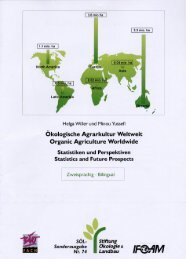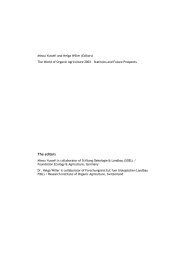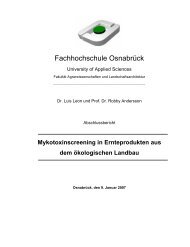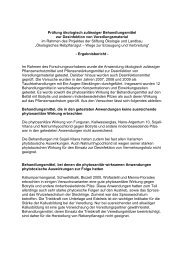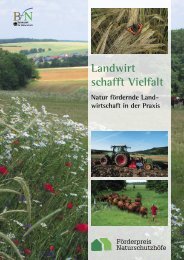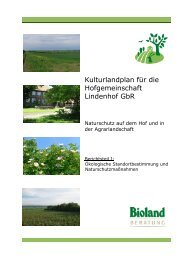the world of organic agriculture - Organic Eprints
the world of organic agriculture - Organic Eprints
the world of organic agriculture - Organic Eprints
You also want an ePaper? Increase the reach of your titles
YUMPU automatically turns print PDFs into web optimized ePapers that Google loves.
9 Standards and Regulations<br />
In 2002, an International Task Force on Harmonization <strong>of</strong> UNCTAD, FAO and IFOAM initiated<br />
efforts to harmonize <strong>organic</strong> standards and regulations. This partnership between <strong>the</strong> private<br />
<strong>organic</strong> community and <strong>the</strong> United Nations <strong>of</strong>fers a forum for public and private discussions and<br />
aims to initiate <strong>the</strong> development <strong>of</strong> a constructive and effective partnership between <strong>the</strong> private<br />
and <strong>the</strong> public sector.<br />
9.4 Relationship to Fair Trade<br />
Many producer associations in <strong>the</strong> emerging markets and markets in transition conform to<br />
<strong>the</strong> requirements <strong>of</strong> <strong>the</strong> Fair Trade organizations, e.g. FLO (Fair Trade Labeling Organization<br />
International), Transfair, Max Havelaar and World Shops (Weltlaeden). Having a Fair Trade label<br />
does not necessarily mean, however, that <strong>the</strong> products can also be sold as ‚<strong>organic</strong>‘. In order<br />
to use and communicate <strong>the</strong> term “<strong>organic</strong>”, <strong>the</strong> project must be subject to accredited <strong>organic</strong><br />
inspection procedures.<br />
IFOAM maintains close contacts with FLO and its members, since a large number <strong>of</strong> projects<br />
conform to <strong>the</strong> standards <strong>of</strong> both organizations. The combination <strong>of</strong> ‚<strong>organic</strong>‘ and ‚fair trade‘<br />
labeling can enhance a product‘s market prospects. Additional information and regulations can<br />
be downloaded at www.flo-international.org.<br />
9.5 Literature<br />
Commins, Ken (2003): Overview <strong>of</strong> current status <strong>of</strong> standards and conformity assessment systems, Discussion Paper<br />
from <strong>the</strong> International Task Force on Harmonization, October 2003<br />
European Commission, Directorate-General for Agriculture (2001): „<strong>Organic</strong> farming - Guide to Community rules“,<br />
Brussels, 2001, Available at http://europa.eu.int/comm/<strong>agriculture</strong>/qual/<strong>organic</strong>/brochure/abio_en.pdf<br />
IFOAM Conference on <strong>Organic</strong> Guarantee Systems, Conference Conclusions, February 2002<br />
Kilcher Lukas et al (2004): The Market for <strong>Organic</strong> Food and Beverages in Switzerland and <strong>the</strong> European Union. Overview<br />
and market access information, pp 156, Forschungsinstitut fuer biologischen Landbau (FiBL) und<br />
Swiss Import Promotion Program (SIPPO), Second Edition Frick/Zuerich January 2004, ISBN 3-906081-<br />
03-06<br />
83


